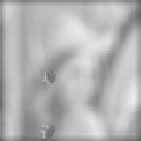Image Processing Reference
In-Depth Information
O
/∼
B
=
{x
/∼
B
| x ∈ O},
(8.4)
x∈O
x
/∼
B
=
O,
(8.5)
∀x, y ∈ O
(
x
/∼
B
)
∩
(
y
/∼
B
)=
∅.
(8.6)
Example 8.2
Figure 8.3a shows an image of size 256
×
256 pixels and their subimages. Let
O,
F
be a perceptual system where
O
denotes the set of 25
×
25 subimages.
A) The original image
B) A subimage in the covering
A) The original image
B) A subimage in the covering
(b)
(a)
(a)
(b)
C) The equivalence class on a white background
D) The equivalence class marked on image
C) The equivalence class on a white background
D) The equivalence class marked on image
(c)
(d)
(c)
(d)
(8.3a) An equivalent class
(8.3b) A tolerance class
FIGURE 8.3: An image and one of its equivalence (Left) and tolerance (Right)
classes
Let
B
=
{φ
1
(
x
)
}⊆
F
is the set of only one probe function
φ
1
where
φ
1
(
x
)=
gray
. The two marked subimages
are perceptually indiscernible with respect to their gray level values and hence they
are named an
equivalence class
. The equivalence class is shown both individually
(c) and on top of the image where the rest of image is blurred (d).
(
x
) is the average gray scale value of subimage
x
Perceptual indiscernibility relation can also be defined in a weak sense as follows
Perceptual Weak Indiscernibility Relation
(Peters and
DEFINITION 8.3
Wasilewski, 2009; Peters, 2009)
Let
O,
F
be a perceptual system. Let
B
=
{φ
1
,φ
2
, ..., φ
l
}
and
x, y ∈ O
. A percep-
tual weak indiscernibility relation
∼
B
is defined relative to
B
as follows









Search WWH ::

Custom Search